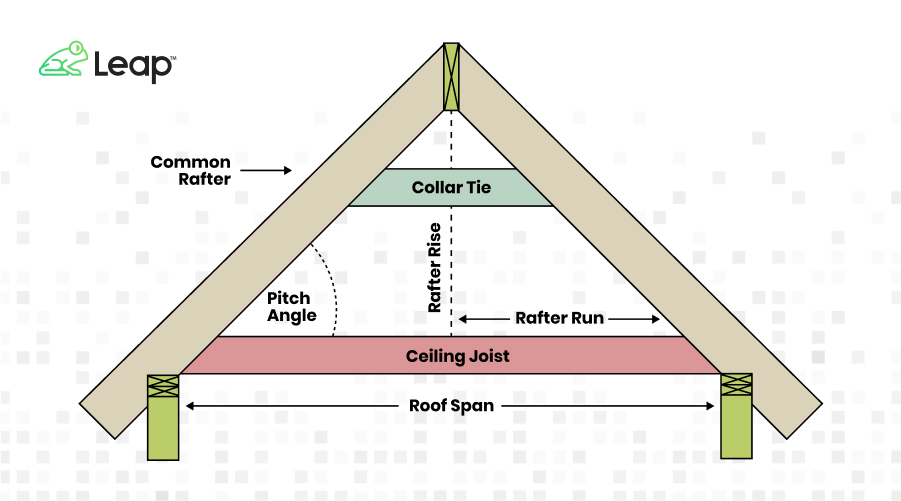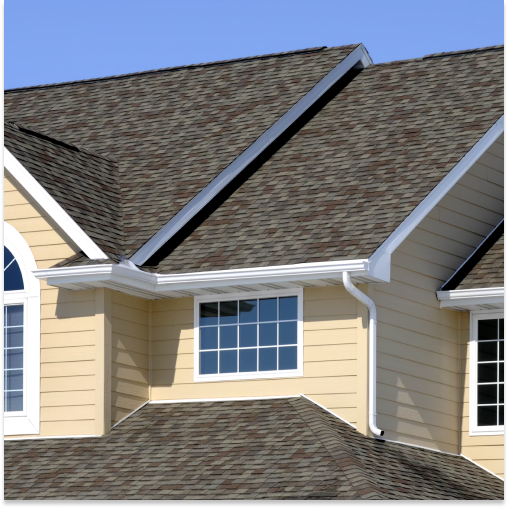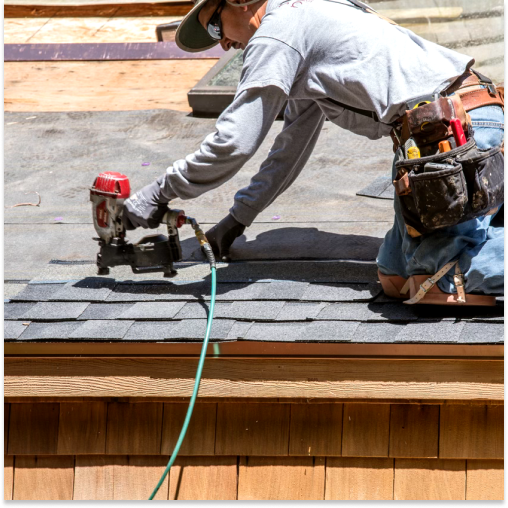Knowing how to measure roof pitch is a fundamental skill for roofing contractors. In fact, accurate pitch measurements impact project estimates, material selection, and water drainage in the future.
Understanding the pitch helps contractors choose the right materials and ensures the roof’s durability and functionality. It also aids in calculating the amount of material needed to prevent shortages or excesses for your business.
For roofing contractors, mastering this skill means delivering precise estimates and completing projects efficiently. Therefore, this comprehensive guide will walk you through the entire process of measuring roof pitch. From understanding what roof pitch is and why it matters to learning the step-by-step calculation method, you will gain the knowledge needed to tackle any roofing project.
What is Roof Pitch?
Roof pitch, the slope or angle of a roof, plays a crucial role in various aspects of roofing projects. And knowing how to measure roof pitch is essential for roofing contractors.
The roof pitch refers to the slope or angle of the roof. It’s expressed as the ratio of the vertical rise to the horizontal span. For example, a 6/12 pitch means the roof rises 6 inches for every 12 inches of horizontal span. In general, roof pitch is commonly expressed as a fraction based on 12s.
Understanding roof pitch is important for several reasons. First, it affects the roof’s ability to shed water. A steeper pitch allows water to run off more quickly. This is vital in preventing leaks and water damage.
Second, roof pitch impacts material choices. Certain roofing materials are better suited to specific pitches. For instance, shingles are ideal for steeper pitches.
Third, knowing the pitch helps in estimating the amount of roofing material needed for any given job. Specifically, accurate measurements prevent material shortages or overages, saving time and money for your business.
Lastly, safety is a key concern. Steeper roofs are more challenging and dangerous to work on. Proper pitch measurement ensures that contractors take necessary safety precautions before the job begins.

Key Terms to Remember When Measuring Roof Pitch
When learning how to measure roof pitch, you need to understand several key terms. These terms will help you communicate accurately and work efficiently during the process. For example, the key terms to remember include:
- Roof Span: The distance between the outer edges of the roof. It runs horizontally from one side of the roof to the other.
- Rafter Rise: The vertical distance that the roof climbs. This measures how high the roof goes from the base to the peak.
- Collar Tie: A horizontal beam that connects two opposite rafters. It’s located near the roof’s peak and helps prevent the roof from spreading apart. The collar tie plays a role in the structural integrity of the roof.
- Ceiling Joist: Horizontal structural members that support the ceiling. They run parallel to the roof span and provide a base for the ceiling material. Ceiling joists also help tie the walls together and distribute weight.
- Pitch Angle: The actual angle formed by the roof’s slope. It can be measured in degrees. Understanding the pitch angle is important for precise measurements and proper material selection.
These key terms will come in handy as you begin to calculate the roof pitch. As a matter of fact, understanding roofing structure is a necessity for everyone within the business, from the sales reps to installation crews.
How to Measure Roof Pitch Step-by-Step
With today’s technology making calculations for roofing jobs has never been easier. However, traditional methods are still the standard for certain measurements. To measure roof pitch accurately, follow these steps:
- Gather Tools: You will need a ladder, a level, a tape measure, and a pencil.
- Access the Roof: Safely set up your ladder and climb to a point where you can measure the roof.
- Place the Level: Position the level horizontally against the roof’s surface.
- Mark the Level: Using the pencil, mark a point on the level at 12 inches from one end.
- Measure the Rise: From the 12-inch mark, measure vertically to the roof’s surface. This distance is the rafter rise.
- Calculate the Pitch: Divide the rafter rise by 12 to determine the roof pitch. For example, if the rise is 6 inches, the pitch is 6/12.
Alternatively, you can use a pitch gauge or an application designed for measuring roof pitch. These tools can provide more accurate results with less effort.
Different Types of Roofs to Measure
Residential roofs come in various types with unique measurement challenges. Understanding each type will help you during the estimating process.
- Gable Roof: Two sloping sides that meet at a ridge. It’s one of the most common roof types. Measuring a gable roof involves taking measurements from the eave to the ridge on both sides.
- Hip Roof: Slopes down on all four sides. It has a more complex structure than a gable roof. Measuring a hip roof requires multiple measurements and calculating the average pitch.
- Mansard Roof: Two slopes on each side, with the lower slope being steeper. This type of roof is often seen on historic buildings. Measuring a mansard roof involves determining the pitch of both slopes separately.
- Gambrel Roof: Similar to a mansard roof but has two slopes on each side like a barn roof. The lower slope is steeper than the upper one. Accurate measurement of both slopes is necessary.
- Flat Roof: A flat roof has a minimal slope, usually less than 3/12. Although it appears flat, it still has a slight pitch for water drainage. Measuring a flat roof involves checking for any variations in the slope.
As you can see, there are a lot of factors you must consider when determining how to measure roof pitch for a potential job. No two jobs are the same. And over time, you will likely come across each of these types of roofs. So, how can you streamline this process?
Streamline Your Measurements with Software
Modern software tools can simplify the process of measuring roof pitch. These tools offer precise measurements and reduce the risk of human error.
That’s why Leap SalesPro provides partner integrations with the industry’s leading measurement tools. This includes aerial imagery and 3D modeling to measure roof pitch accurately. It’s the best way to save time during the sales process and improve accuracy for your estimates.
Better yet, Leap SalesPro is a roofing software that goes well beyond your measurements. You can create the most accurate estimates in the industry, quickly turn them into appealing proposals, and generate dynamic contracts once the work is approved.
With Leap’s lending partners, you can offer financing and receive loan approvals in minutes. Furthermore, you can sign contracts directly within the software, send invoices, and collect payments.
Leap SalesPro not only helps to strengthen your estimating process, but also helps to provide a better customer experience. With a modern and professional presentation, you can build trust with homeowners and win more jobs for your business.
Overall, knowing how to measure roof pitch correctly is an invaluable skill for roofing contractors. And with the right tools, you can make this process effortless and guarantee accuracy. Therefore, are you ready to improve your measurements and optimize your workflow? If so, fill out the form below and schedule a quick Leap SalesPro demo with one of our software experts.




